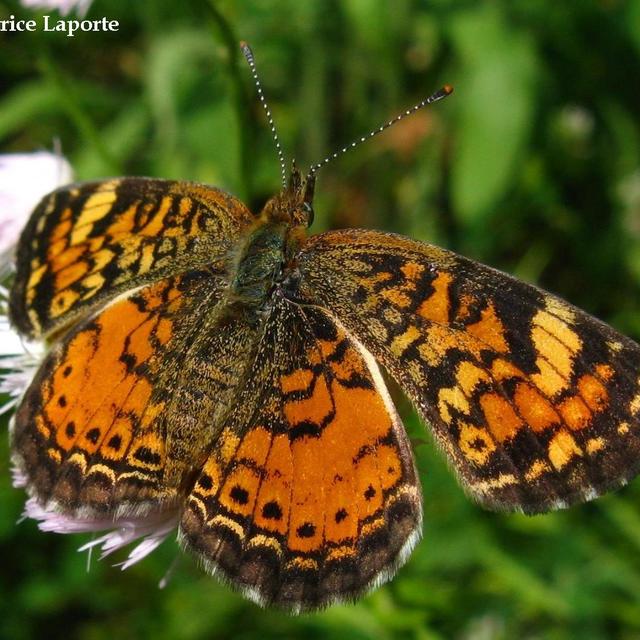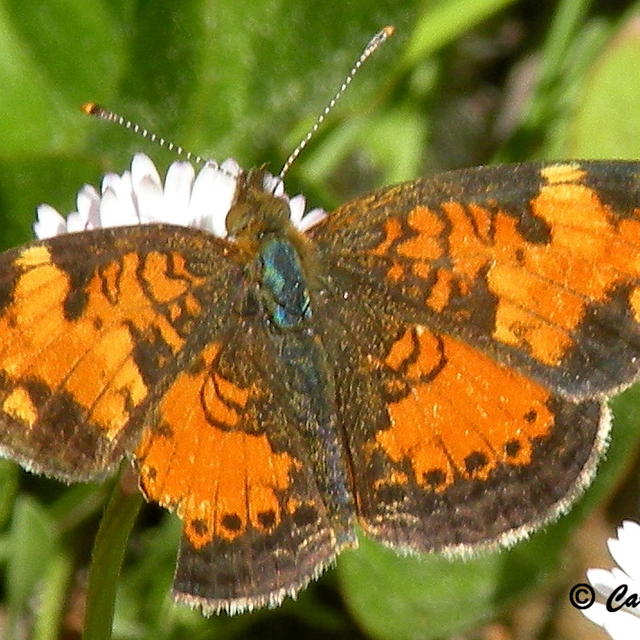Northern Crescent
Phyciodes cocyta (Cramer, 1777)
Family: Nymphalidae
Subfamily: Nymphalinae
Identification: Antennal clubs of male are orange. Females are darker than males. Upperside is orange-brown with dark borders; median orange-brown areas are mostly open, with few dark markings. Underside of hindwing is orange with a tan patch surrounding the pale marginal crescent.
Wing Span: 1 1/4 - 1 7/8 inches (3.2 - 4.8 cm).
Life History: All day long, males patrol near the host plants for receptive females. Eggs are laid in bunches of about 40 on the underside of host plant leaves. Caterpillars eat leaves, and young ones live and feed communally. Third-stage caterpillars hibernate.
Flight: One brood from June-July, perhaps two broods in southern Canada.
Caterpillar Hosts: Asters, in the sunflower family (Asteraceae).
Adult Food: Nectar from flowers of dogbane, fleabane, and white clover.
Habitat: Moist open areas in rocky places, wooded streams, marsh edges, and shale barrens.
Range: Newfoundland and northern New England west across the Great Lake states and southern Canada to British Columbia; south in the western mountains to Utah, southeast Arizona, and southern New Mexico; south in the Appalachians to Pennsylvania, Virginia, and West Virginia.
Conservation: Some geographically restricted subspecies and unnamed populations should be monitored, managed, or preserved.
NCGR:
Management Needs: Maintain habitat integrity, host plant colonies, and nectar sources.
BAMONA Shop
Please donate!
We depend on donations to keep Butterflies and Moths of North America freely available. We want to express our gratitude to all who showed their support by making a contribution this year. You can donate to support this project at any time.
Advertise with us!
Do you have a product or service that you think would interest BAMONA users? If you would like to advertise on this website, contact us by email, or use the contact form and select the "Advertising" category.
Verified Sightings
Displaying 1 - 24 of 1710 verified sightings

Observation date: Jul 02, 2010
Submitted by: stevecary
Region: Otero County, New Mexico, United States
Verified by: stevecary
Verified date: Mar 12, 2025

Observation date: Jul 05, 1981
Submitted by: stevecary
Region: Lincoln County, New Mexico, United States
Verified by: stevecary
Verified date: Mar 11, 2025

Observation date: Jun 15, 2024
Submitted by: Joshua C
Region: Colfax County, New Mexico, United States
Verified by: stevecary
Verified date: Feb 19, 2025

Observation date: Aug 09, 2024
Submitted by: jrmbutterfly
Region: British Columbia, Canada
Verified by: Paul Prappas
Verified date: Dec 08, 2024

Observation date: May 19, 2023
Submitted by: jrtindall
Region: Mercer County, New Jersey, United States
Verified by: jwileyrains
Verified date: Nov 20, 2024

Observation date: Jul 07, 2024
Submitted by: bonfrey
Region: La Plata County, Colorado, United States
Verified by: mikefisher
Verified date: Nov 17, 2024

Observation date: Sep 16, 2024
Submitted by: Trish W
Region: Belknap County, New Hampshire, United States
Verified by: John Calhoun
Verified date: Sep 23, 2024

Observation date: Sep 15, 2024
Submitted by: NikkiM
Region: Carbon County, Montana, United States
Verified by: J_Martineau
Verified date: Sep 17, 2024

Observation date: Jun 08, 2021
Submitted by: Al R
Region: Ontario, Canada
Verified by: jmgesell
Verified date: Sep 10, 2024

Observation date: Jul 07, 2022
Submitted by: ButtahflyEtn37354
Region: Orange County, New York, United States
Verified by: jmgesell
Verified date: Aug 31, 2024

Observation date: Aug 24, 2024
Submitted by: pgrew1@unl.edu
Region: Penobscot County, Maine, United States
Verified by: John Calhoun
Verified date: Aug 30, 2024

Observation date: Aug 27, 2024
Submitted by: dnight30
Region: Carroll County, New Hampshire, United States
Verified by: John Calhoun
Verified date: Aug 28, 2024

Observation date: Aug 21, 2024
Submitted by: kittybev
Region: Ontario, Canada
Verified by: jmgesell
Verified date: Aug 23, 2024

Observation date: Aug 16, 2018
Submitted by: Puccini
Region: Brookings County, South Dakota, United States
Verified by: J_Martineau
Verified date: Aug 23, 2024

Observation date: Aug 13, 2024
Submitted by: Tom Dudones
Region: Franklin County, New York, United States
Verified by: jmgesell
Verified date: Aug 14, 2024

Observation date: Aug 13, 2024
Submitted by: Tom Dudones
Region: Franklin County, New York, United States
Verified by: jmgesell
Verified date: Aug 14, 2024

Observation date: Jul 09, 2024
Submitted by: bkzonline
Region: Bonner County, Idaho, United States
Verified by: stevekohler
Verified date: Jul 31, 2024

Observation date: Jul 28, 2024
Submitted by: Bahession
Region: Flathead County, Montana, United States
Verified by: J_Martineau
Verified date: Jul 29, 2024

Observation date: Jul 08, 2024
Submitted by: Cascade Colors
Region: Summit County, Colorado, United States
Verified by: mikefisher
Verified date: Jul 26, 2024

Observation date: Jul 21, 2024
Submitted by: Elisabeth_Cassinari
Region: Worcester County, Massachusetts, United States
Verified by: jwileyrains
Verified date: Jul 25, 2024

Observation date: Jul 20, 2024
Submitted by: GeraldWolfe
Region: British Columbia, Canada
Verified by: Paul Prappas
Verified date: Jul 24, 2024

Observation date: Jun 28, 2024
Submitted by: Jon Kindschy
Region: Montrose County, Colorado, United States
Verified by: mikefisher
Verified date: Jul 23, 2024

Observation date: Jul 15, 2024
Submitted by: dnight30
Region: Carroll County, New Hampshire, United States
Verified by: John Calhoun
Verified date: Jul 21, 2024

Observation date: Jul 19, 2024
Submitted by: BeaLaporte
Region: Ontario, Canada
Verified by: jmgesell
Verified date: Jul 20, 2024
- 1 of 72
- next ›
















